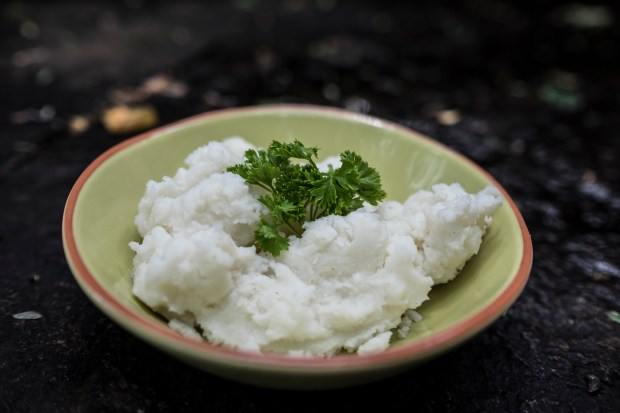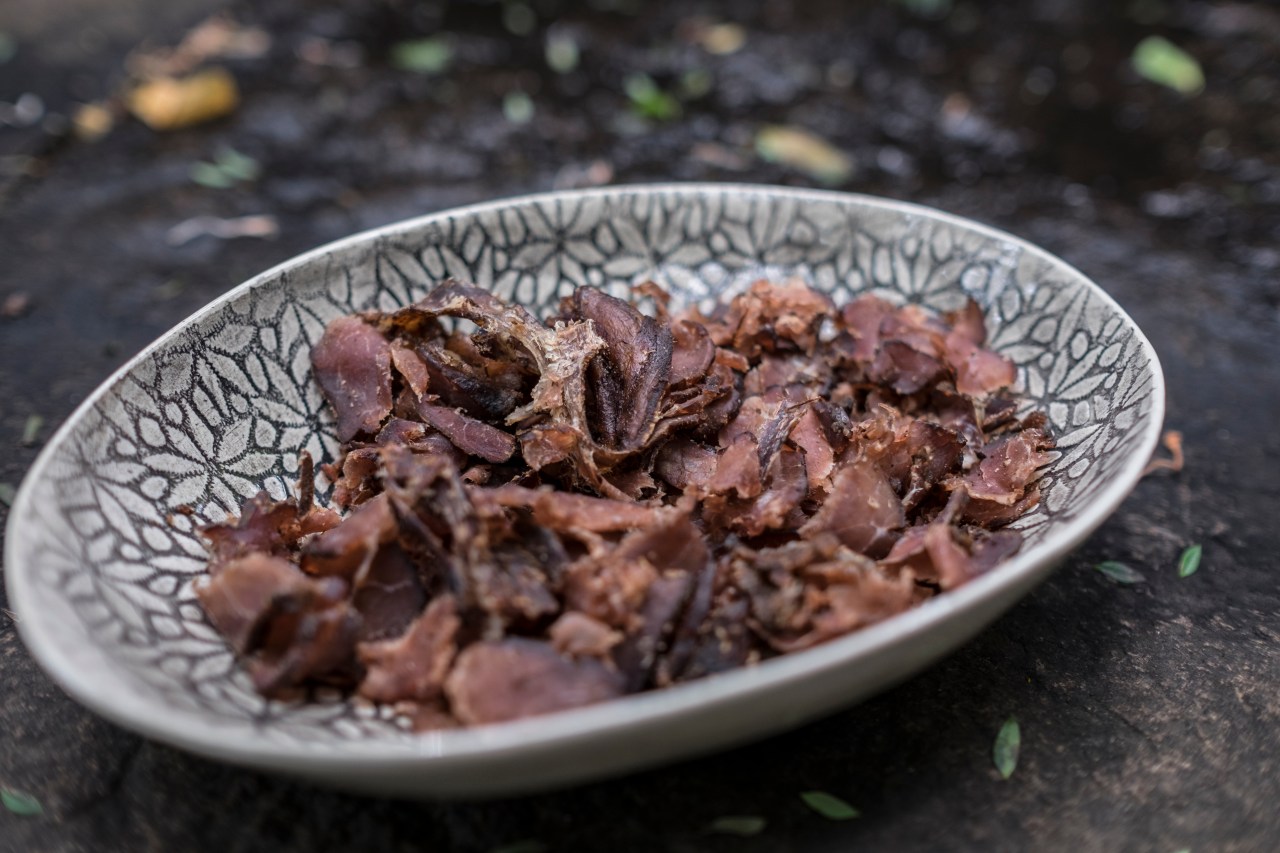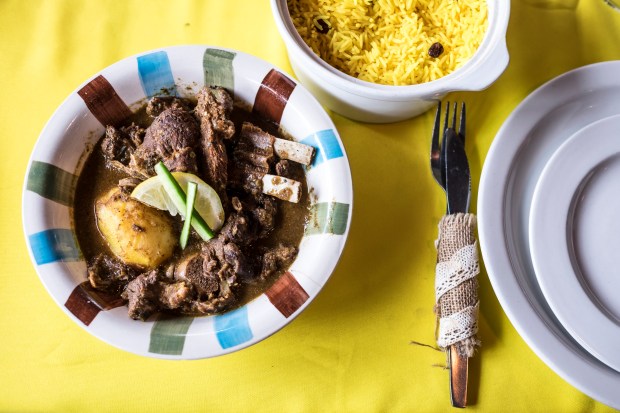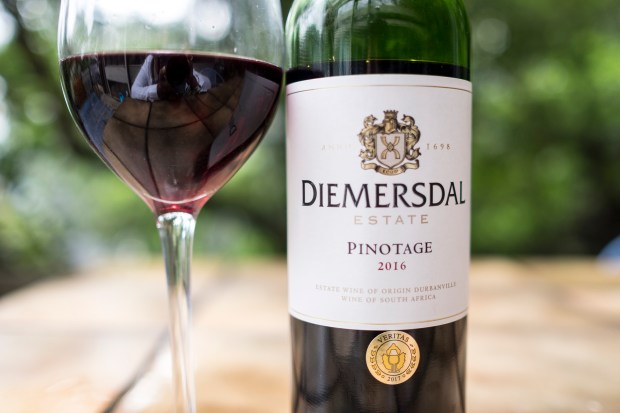South Africa’s identity is complicated, contested and unresolved. While Archbishop Tutu’s “rainbow nation” remains a noble aspiration, the current forecast is increasingly stormy. So, while it’s tempting to read South African cuisine simply as some kind of melting pot of the influences brought by those who migrated to the country, many of the country’s most notable and tasty dishes reflect histories of violent conquest, enslavement, and oppression. But even as post-apartheid South Africa remains locked in an unfinished struggle to digest and resolve the consequences of its troubled history and to recast a fresh identity based on equality and justice, its cuisine reflects the common humanity of its citizenry: their search for succor and comfort, identity, communion, and hope for a better day.
To the visitor, it offers not only a pleasing set of taste sensations, but also a nutritious primer of the country’s history. Herewith, some Cliff Notes to eating your way through that syllabus.
Pap
The signature staple, eaten by the majority of South Africans, would have to be a corn porridge—pap in Afrikaans. But which one?
Ungqushu, or samp and beans, as it might be dubbed in English, is probably the winner. Samp would be recognizable to Americans as dried hominy; although once smashed into fragments, rehydrated, and boiled along with dried beans, it doesn’t bear much resemblance to grits. Rich in protein, carbohydrates, and roughage, it’s a basic sustenance that can be complemented by a number of different meats and vegetables.
Ungqushu has a strong competitor in phutu, a drier, more crumbly corn porridge, reminiscent of a coarse polenta. This version requires company to fulfill its nutritional mission—eat with (most tastily) boerewors (fire-grilled coils of traditional sausage, featuring beef and sometimes pork or lamb), chakalaka, (a spicy vegetable relish in which beans are optional), the protein-rich wild spinach known as morogo, or even pumpkin. Sometimes even the soured milk known as amasi will do.

Corn is not indigenous to Africa; it is believed to have been introduced across the continent by Portuguese explorers in the 15th century. Sorghum and millet were the dominant grain staples among South Africa’s black population prior to the forced urbanization that followed the discovery of diamonds and gold in the late 19th century.
Today sorghum still features in an African diet, but mostly as the grain base of the traditional sour fermented beer known as umqomboti (whose status as the tipple of the migrant African working class was celebrated in this iconic ’80s pop hit by Yvonne Chaka Chaka). Corn was adopted as a cash crop by black peasant farmers before it was cultivated by white commercial farmers. The system of forced migration of black men off the land and into the grim migrant-worker compounds around the diamond mines of Kimberley and the gold mines around Johannesburg created the market for the dried-corn products that became the staples of the black South African diet. The need to feed tens of thousands of men consciously coerced into wage labor by government taxes and the land restrictions imposed on their cashless rural subsistence economy created a massive market for grain cultivation by white commercial farmers. Corn was easier to cultivate than millet or sorghum for the reduced workforce left behind on small subsistence plots. And so the corn-porridge basis of the modern black South African diet was born.
This migrant-labor system, created to build the wealth of a powerful white minority on the backs of a highly exploited and politically disenfranchised black majority was the cornerstone of the reviled system that became known to the world as apartheid. South Africa’s ubiquitous corn porridge was arguably its culinary outcome.
Biltong

At New York’s Kennedy Airport, there was for years a designated bin in the customs hall receiving flights from South Africa where passengers were encouraged to toss their biltong—dried meat jerky—before it was discovered by customs officers and read as an attempt to break the law prohibiting the uncontrolled import of meat products. It was safe to assume that anyone returning from South Africa would be trying to bring in a few sticks of the irresistible snack, made of cured and lightly spiced dried cords of beef, springbok, or ostrich meat.
Biltong is a taste of home coveted most strongly by South Africans living abroad. It has taken on an identity associated with the Afrikaner Voortrekkers whose ox-wagon migration from the Cape led to white colonization of the South African hinterlands. However, biltong in fact originated with the Khoi (Bushmen), the country’s indigenous hunter-gatherers, who needed to preserve the fruits of the hunt for survival and for whom the sun was the only available technology.
Like rooibos tea, biltong was an ingenious innovation appropriated by the white arrivistes who rapidly displaced them. Beef became the norm in the age of mass agriculture—Khoi biltong would have been predominantly wild game such as springbok, which is tasty enough. An equally tasty but fattier competitor or accompaniment is droe wors (dried sausage): no further description needed. The tastiest of all biltong varieties is unquestionably ostrich. It was tales of the money made by a handful of entrepreneurs who in the 1920s farmed ostriches for their feather boas that helped persuade my Yiddish grandfather to migrate from Belarus to South Africa in 1930—by which time, of course, the global market for feather boas of the Roaring ’20s had collapsed. Ostriches are still husbanded in South Africa today, though, mostly for their eggs and meat.
From bredies to bobotie
The Dutch colonization that began in the late 17th century built the foundation for perhaps the most distinct cuisine in South Africa, although that cuisine has little to do with Netherlandish traditions. As its name, Cape Malay, suggests, it’s rooted in the spices imported to the Cape from the Dutch colonies in what we know today as Indonesia and Malaysia—and in the use of those spices by the Javanese slaves brought to the cape to work the farms of the Dutch colonists. In another one of those ironic culinary consequences of social struggle, it could be argued that the resistance of the indigenous Khoi and San to being pressed into servitude on Dutch farms produced the Malay signature of South Africa’s most unique food culture.

Cape Town is cold and wet in winter, raising the desirability of the bredie—a slow-cooked stew based on bony lamb (shanks, knuckles, or neck) cut into 1 ½-inch chunks and a vegetable signature: tomato bredie; green-bean, pumpkin, or cabbage bredie; and, most exotic of all to the traveling gourmand, waterblommetjie bredie. (Waterblommetjie literally translates as “pond weed,” referring to a wild vegetable found on bodies of water in the rural areas around Cape Town in winter and early spring; it’s something akin to a wild artichoke with a peppery, lemony taste.)
An even more distinct and even festive offering from the Cape Malay tradition—and cheaper than stewing lamb—is bobotie: ground lamb or beef (or both) slow-cooked in an exquisite combination of turmeric and other curry spices, bay leaves, chopped almonds, and fruits (dried apricots, fresh apple, golden raisins) allspice, fruit chutney, and then topped with an egg custard and baked. It’s served with the delightfully named begrafenis rys (funeral rice, named for its place in mourning fare), heavy with ginger, turmeric, cloves, and raisins. Often called the signature South African dish, bobotie is a treat not to be missed.
South African curries
The British empire played a major role in creating an Indian diaspora by sending impoverished indentured laborers to sugar-cane plantations as far away as Trinidad and, yes, South Africa’s Indian Ocean province Natal. A merchant class soon followed, and by the late 19th century there was a sizable Indian population in South Africa—most famously including a young lawyer by the name of Mohandas K. Gandhi. As is often the case in diaspora cuisines (see, for example, “Italian” in the U.S.), regional distinctions blur and are eliminated in the name of a new communal mélange (or is masala a better term here?). Journalist Sarah Khan has written, “When Indians began arriving in Durban from Kerala, Tamil Nadu, Andhra Pradesh, Gujarat, and Karnataka in small numbers, traditions and flavors that never had occasion to interact back home began coalescing on faraway shores.”
The easy availability of some spices and ingredients and the absence of others helped shape a distinct “Indian” cuisine in South Africa that visitors from the subcontinent often notice is quite different from what they know back home. The exile hybrid of regional Indian traditions is said to be far hotter yet tangy and delicious.

The appetite for meat curries is hardly confined to the Indian communities. The origin of the bunny chow, as you’ll read below, is eloquent testimony to the fact that the curries originating in those communities have for decades also been coveted by the African majority: Nelson Mandela’s favorite haunt before his imprisonment was the Johannesburg curry joint Kapitan’s, founded in 1887.
While Durban’s hot mutton curries and biryanis are delectable, its prawn curry—chock-full of the large shrimp that breed off the Indian Ocean littoral is an exquisite taste not to be missed.
But curry is an umbrella term, and the Malay variety that dominates in Cape Town is quite different—not as hot, somewhat sweeter, relying on aromatic blends of turmeric, coriander, cardamom, fennel seeds, and cinnamon and a stronger presence of tomatoes.
Your South African curry experience is simply incomplete without sampling both.
Bunny chow, salomie, and vetkoek: proletarian street food
An urban working class needs to be able to find cheap, tasty nourishment on the go—some fried, steamed or baked version of the universal combination of meat, fat, and dough that can be eaten without crockery or cutlery.
The most storied, idiosyncratic, and iconic offering on South Africa’s streets is surely the bunny chow. It’s a half Pullman loaf of white bread, hollowed out to create a crevice, into which is poured a steaming Indian mutton curry. It’s to be eaten with the fingers, tearing pieces off the bread “bowl” to scoop out the rich lamb and potato chunks swimming in a sauce that turns the bread a rich orange color. It’s an extraordinary and unique street food, whose origins lie, once again, in the arcana of South Africa’s old segregationist laws and migrant-labor system.
The origin stories of “the bunny,” as it’s known, are as varied as those concerning Britain’s national dish, chicken tikka masala, but they all involve apartheid policies of exclusion. One theory is that the forbidding of Indian grocers from selling hot meals to African migrant workers prompted them to disguise a curry as a permissible loaf of bread. Another is that it was invented simply as a takeout vessel Indian restaurateurs could sell from the back door to black patrons legally barred from entering. A street food concocted as an act of subversion of apartheid laws!
Bunny chows are a Durban-Joburg street-food standard, reflecting those cities’ substantial Indian population. Cape Town’s Indian population is tiny, but the city’s “coloured” majority—architects and custodians of the Cape Malay tradition—has its own street-food contender in the form of the salomie. There is no better way to consume a Malay curry than inside the salomie’s flaky, buttery Malay roti, filled with a mutton or kheema (ground beef) curry (as with bunnies, beans and chicken curries are also options), rolled and wrapped like a burrito and eaten in one hand on the street. While you wait for your salomie, don’t miss the opportunity to sample a Cape Town samosa, which shares only the name, shape, and oily provenance with its Indian cousin. The Malay samosa is smaller, its pastry shell is spring-roll thin and layered, and its filling is aromatic coriander- and turmeric-heavy ground beef.
A third contender in the proletarian cholesterol-bomb meal-in-one-hand stakes would be vetkoek (literally “fat cake”), or, as it’s known in Zulu, amagwinya. A common street snack around Soweto and other centers of the African working class around Johannesburg, vetkoek is as simple as a deep-fried ball of basic dough (flour, water, baking powder or yeast, salt, sugar), pulled open and stuffed with a savory (usually slightly curry-inflected) ground beef. It’s even better when the meat sauce is poured into the dough ball before it’s sealed and dropped in the oil. Its origins are said to lie in Dutch oliebollen, making for a quick alternative to bread among the Afrikaner Voortrekkers and farmers on the road; but in the late 20th century it was more common as a belly-warming standard on cold winter days and nights near the hubs of commuter mass transit around Joburg.
And more recently, relative economic opportunity in post-apartheid South Africa has attracted legions of migrants from Congo, Nigeria, Francophone West Africa, Somalia, Ethiopia, Zimbabwe, and Pakistan, communities that have contributed a delicious expansion of the street food and cheap restaurants options in South African cities.
Snoek

Very few cities anywhere in the world can match Cape Town’s claim to being the only home of a species of fish so unique and delightful that memories of its bony, gamy flesh, fried or braaied or smoked, are a siren song of home for the city’s diaspora. Don’t take my word for it: U.S. food writer emeritus Calvin Trillin devoted an entire New Yorker feature to parsing its unique attraction. It’s a fighting fish distantly related to the barracuda; when they catch it on the line in the icy waters off Cape Town, those who reel it keep a bludgeon handy to dash the razor teeth from the head of the struggling fish as they land it on deck, lest it draw blood in its last throes. It’s filled with long, sharp bones that have to be carefully navigated, but the unique gaminess of its flesh is without peer or parallel.
Snoek can be butterflied and braaied on an open fire (basted with a heady concoction of apricot jam, lemon, garlic and cumin); it can be smoked and served cold or mashed into an exceptional pate; or it can be served up in a smoor—a spicy tomato-based saute—and mopped up with white bread. But it comes best batter-fried and wrapped in unprinted newsprint with a side of “slap chips”—the floppy South African take on the french fry—with a healthy dollop of salt and brown vinegar.
Yes, you’re going to get your best snoek experience from a fish-and-chips stand.
Bonus track: Pickled fish
Cape Town’s “coloured” population has long been the city’s majority population. It’s a distinct ethnic group whose origins lie in the indigenous people, the Muslim slaves brought from Java to the Cape by the Dutch, and numerous intimacies among South Africa’s various arriviste populations over the centuries. Their numbers are fairly evenly divided between Christian and Muslim households, with families often having branches in both confessions (the exclamation “God-Allah!,” used as a kind of “OMG!” in the coloured community, is a reminder that the present company might in any given social situation include believers who know the Almighty by either of these names.) The best epicurean expression of this convivienca would be the far-too-humbly-named pickled fish—which, residents of the Cape know, is de rigueur on Good Friday in both Christian and Muslim homes.
There are myriad household versions of this dish. Snoek is a great base, but so is cod or yellowtail. Then it’s essentially a sweet-and-spicy combination of fried fish, onion, turmeric, cumin, and other masala spices, onions, garlic, vinegar, bay leaves, allspice, cloves, and sugar, pickled overnight or for a few days and eaten cold. Christian-Muslim hostility is largely unknown in Cape Town; communion over the exquisite culinary traditions of both religions is a well-established tradition.
Piri piri
The international isolation of the apartheid era meant that the ubiquitous fast-food chains of globalization arrived fairly late. Still, it was a known rule among the angry township youth, venting their rage against the system by burning down symbols of oppression, that KFC was off limits. Attacking it would provoke the ire of a huge, loyal township following. While it’s possible these days to find McDonald’s and Burger King, KFC, etc., in any South African city, what’s truly remarkable is that post-apartheid South Africa has managed to export a chain of its own: Nando’s. Its flame-grilled butterflied piri piri chicken is a spicy treat and a marker of the liberation of southern Africa that began with decolonization of Angola and Mozambique in 1975, following the overthrow of Portugal’s fascist dictator Antonio Salazar. As young rebels of the Soweto uprising fled to the newly liberated Lusophone countries for military training with the African National Congress, so thousands of the Portuguese settlers uncomfortable with the prospect of living under black majority rule made their way to South Africa and the privileges their white skin granted them under apartheid.
They brought with them piri piri—not only the small zinger of a capsicum red pepper, but the associated spice marinade as well—made from the crushed dried chilies, lemon, garlic, paprika, and oregano that infuse either chicken or shrimp with a fiery yet complex and aromatic depth. Piri piri chicken became a standard in the major population centers to which these Portuguese settlers gravitated, and Nando’s turned it into a global brand. Two great things South Africans owe to the liberation of Mozambique and Angola then: the inspiration to confront and defeat the apartheid regime and piri piri chicken!
Pinotage
The Huguenot settlers who arrived at the cape in the late 17th century quickly recognized that the region’s temperate climate of winter rainfall and warm, dry summers produced a terroir not unlike that of southwestern France, and they began to produce wine. The bitter notes of slavery and exploitation were always present in the cape wines that gained an international reputation, but the wines themselves were exceptional.

If there’s a signature South African red, it would have to be pinotage, a local cultivar developed in the 1920s for a light, dry, smoky taste not unlike shiraz. The western Cape’s estates also produce impressive cabernet sauvignons and even more impressive sauvignon and chenin blancs—delicious chilled whites that suit the summer outdoor-dining culture.
Labor relations remain contested on South Africa’s wine estates today, though there are a handful of black vintners emerging in what has long been an exclusively white preserve. And climate change has produced a vicious drought in the western Cape, not only choking off the wine harvest, but also threatening to cut off Cape Town’s drinking-water supply in April of 2018.
Braaivleis—the barbecue that binds
According to a ubiquitous radio ad from the early 1970s, the essence of South African identity was “braaivleis, rugby, sunny skies, and Chevrolet.” While that General Motors pitch was aimed at the ruling white minority at the peak of the apartheid era, grilling meat outdoors on an open fire remains the essential culinary ritual common to all of South Africa’s communities. It’s not hard to see why, in a sunshine country with plenty of open space, plentiful supplies of wood, and a carnivorous palate, that barbecue crosses all social boundaries.
Braaivleis is less a cuisine than it is a ritual, and like many religious rituals it’s something you don’t really do on your own, By nature, it’s a form of communion and bonding. Copious amounts of cold beer are an essential ingredient of the meal whose preparation is on full view for all the guests, who stand or sit around the fire for hours before the food is served.
The three basics that bind most braais are lamb chops, boerewors, and pap. Karoo lamb is tangy and tender. Whether seasoned simply—with salt or a rub of garlic and lemon—or with more complex dry-rubbed masalas, the heat of the coals and the lamb’s fatty edges transforms the chop into a crisp, sweet, juicy, tangy, tender treat (that can’t really be matched by beef). It’s to be eaten off and down to the bone, which itself should be gnawed and sucked dry. Rib chops are more tender, but there are more dimensions to shoulder chops, which are also cheaper.
Boerewors, placed on the fire in a coil, varies according to the butcher, but it contains some combination of ground beef and pork, coriander, nutmeg, allspice, and dark vinegar. The sausage often serves as the infantry to the lamb chops’ cavalry; but it’s juicy, aromatic innards, contained in fire-crisped skin, make it more than ready for a solo role on any braai fire.
Of course, there’s some variety of pap—usually the more crumbly, polenta type, which also requires the spicy relish chakalaka.
Just what you might be served around a South African cookout fire varies widely across regions and social status. Space precludes dwelling on the wonders of potjiekos, the delectable stews slow-cooked in a three-legged Dutch oven over open coals. Nor, sadly, do we have time to explore the sosatie, marinated chicken or lamb chunks sharing a skewer with various spiced fruits and vegetables in another sign of the vast debt owed to the Malay influence on most South African cuisine. Nor can we note the nearly endless varieties of marinade and spice-rub options brought to the basic braai chop by various traditions. Or the influence on the use of coals for vegetable sides such as gem squash, yams, onions, or potatoes, wrapped in aluminum foil and dropped directly into the coals for a delicious crisp and smoky finish. The cheese toasties to accompany the beer while you wait. Or the corn on the cob (mealies), grilled over the flame inside their husk as a starter. Or the coastal options ranging from snoek to kreef (rock lobster). While in South Africa, you’ll start with the basics, but I encourage you to try all of the above and continue your braaivleis education on a weekendly basis, or until your arteries plead for mercy.
There’s a lot more going on at the braai table, but if your paper plate softens under the grease of the lamb chop and boerewors and the relish atop the pap, you really have everything you need—including the promising sense, oft needed in South Africa’s troubled transition away from the inequalities of apartheid, that everything will eventually turn out OK.